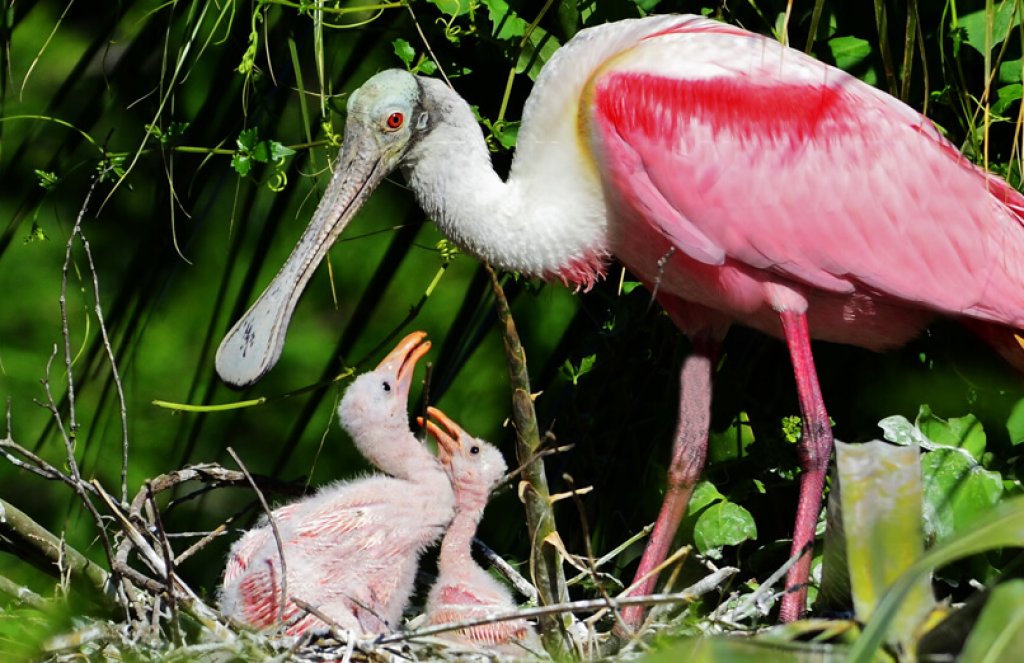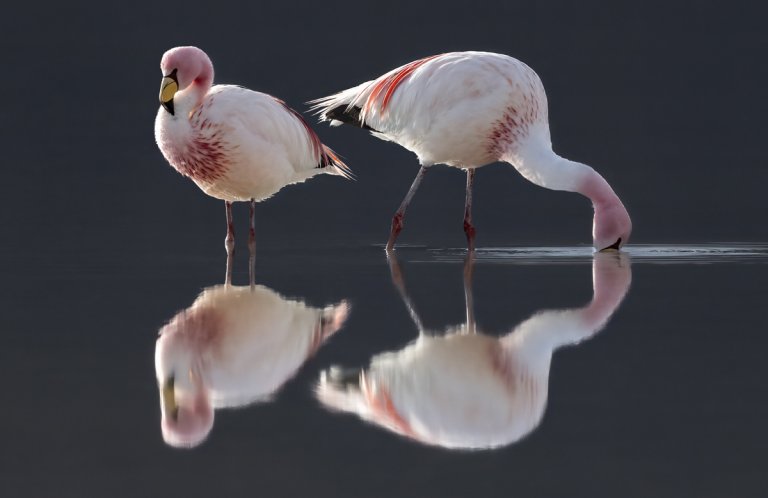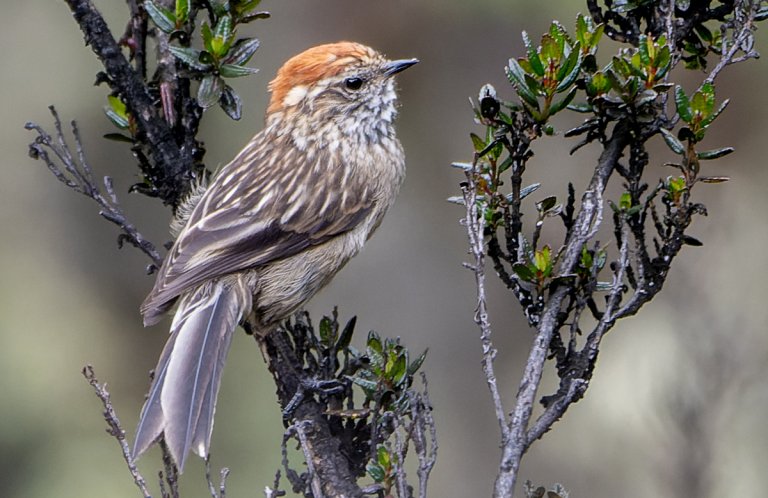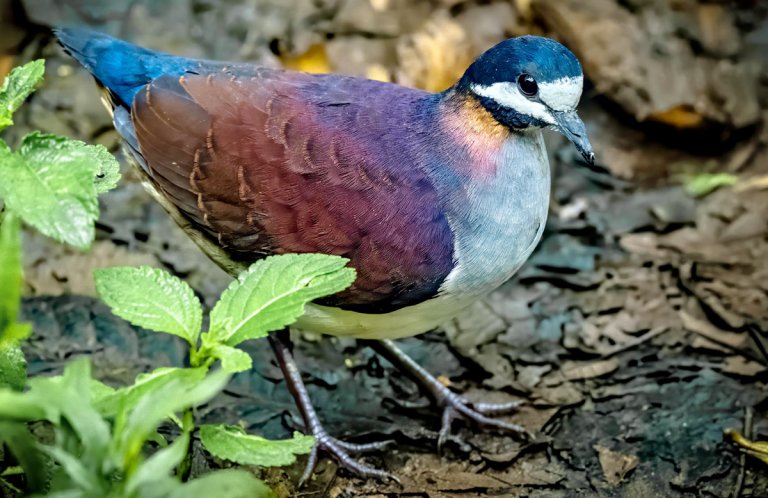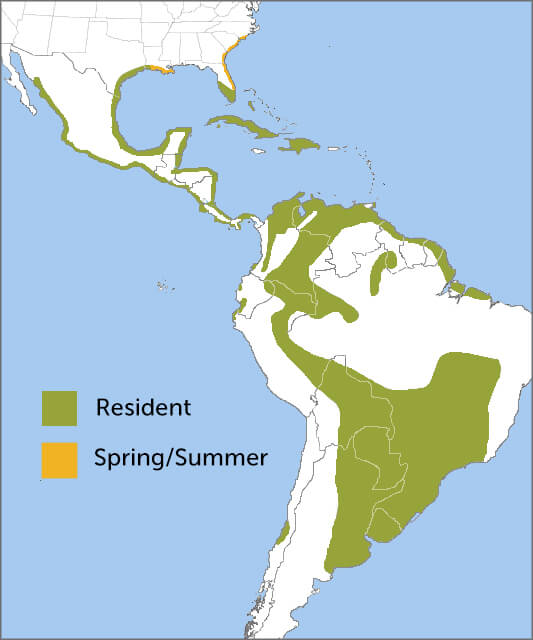
Roseate Spoonbill range map by ABC.
In his 1942 monograph The Roseate Spoonbill, conservationist Robert Porter Allen wrote: “The Spoonbill exhibits paradoxical glamour and drollery.” Decades later, modern field guide author Kenn Kaufman had a similar take: “Roseate Spoonbills are gorgeous at a distance and bizarre up close.”
Often seen in the company of other wading birds, such as the Great Egret, Reddish Egret, and White Ibis, the Roseate Spoonbill truly stands out. With its pink body, crimson shoulder feathers, and orangey tail, this is the most colorful wading bird nesting in the U.S. Understandably, distant spoonbills are frequently mistaken for flamingos, which show up only rarely in the U.S. Closer observation reveals this species' lead-colored head and wide-tipped spatulate bill.
Raised with a Silver Spoon(bill)
The utility of the spoonbill's odd apparatus becomes clear when this bird is in action, feeding. This is when, often in small groups, spoonbills stalk the shallows, bills submerged and heads waving side to side. Beneath the water, the birds' slightly open salad-tong-like bill tips swing back and forth, clamping down on contacted prey. Much of what's on the menu is small fish such as minnows and a wide variety of aquatic invertebrates including crustaceans (crayfish, small crabs, shrimp), insects, and mollusks. Some plant matter is also eaten.
Although it may look cumbersome, this rosy wader's bill deftly performs necessary tasks just as well as those of other species. Like other birds, for example, spoonbills preen, and during courtship, pairs pass sticks to each other and cross bills, rituals that strengthen the pair bond. The bill is also used to gather sticks, twigs, and leaves for the nest.
Spooning the Globe
The Roseate Spoonbill is the “spoonbill of the Americas.” There are five other spoonbill species in the world, all of them white-plumaged. They occur in Eurasia, Africa, and on Australia, New Zealand, and some other islands in Oceania. Fossil records of spoonbills date as far back as around 50 million years ago.
The Roseate Spoonbill is found from the southeastern U.S. to central Argentina. It is a rather scarce nester along the coasts of Mexico, Central America, and parts of the Caribbean, including Cuba. This bird is also found in many low, watery regions in South America, mainly east of the Andes. In fact, the Roseate Spoonbill gets its species name ajaja from the Indigenous Tupi language of upper Amazonia.
Wherever it occurs, the Roseate Spoonbill may move around to take advantage of water levels just right for its bountiful aquatic prey in seasonally flooded savannas, for example, or oxbow lakes. To a lesser degree, this bird is also found along the banks of larger rivers. In the southern part of the range, including Argentina, birds move north in winter.
In the U.S., approximately 3,000 pairs nest in Texas, about 1,500 in Louisiana, and 1,100 in Florida. Pale-pink first-year birds constitute most of the long-distance wanderers that turn up far outside the species' breeding range each year. In recent years, extralimital sightings in the U.S. seem to have become more frequent, including first-record birds in Maine and Minnesota in 2018. This summer was particularly exciting for birders seeking out-of-range spoonbills, including some first state records. Among other places, birds turned up in Connecticut, the District of Columbia, Maryland, Michigan, New York, and Virginia.
Post-breeding dispersal into the Carolinas and Georgia and around the Gulf of Mexico is now commonplace, in some cases leading to nesting. First modern-era nesting records came from Mississippi in 2004, Georgia in 2011, and South Carolina in 2019.
In general, the Roseate Spoonbill is a rather silent species. On its breeding grounds, and sometimes while feeding, it can be heard uttering a low, almost chuckling series of grunts, on the same pitch.
Listen here:
(Audio: Paul Marvin, XC451675. Accessible at www.xeno-canto.org/451675)
Nesting in Numbers
Like the Wood Stork and Brown Pelican, the Roseate Spoonbill nests in colonies, which often include egrets, herons, and ibises. These busy “bird cities” are often prowled below by alligators that feast on fallen young, but also, by their presence, provide some protection to nests from raccoons and other arboreal predators.
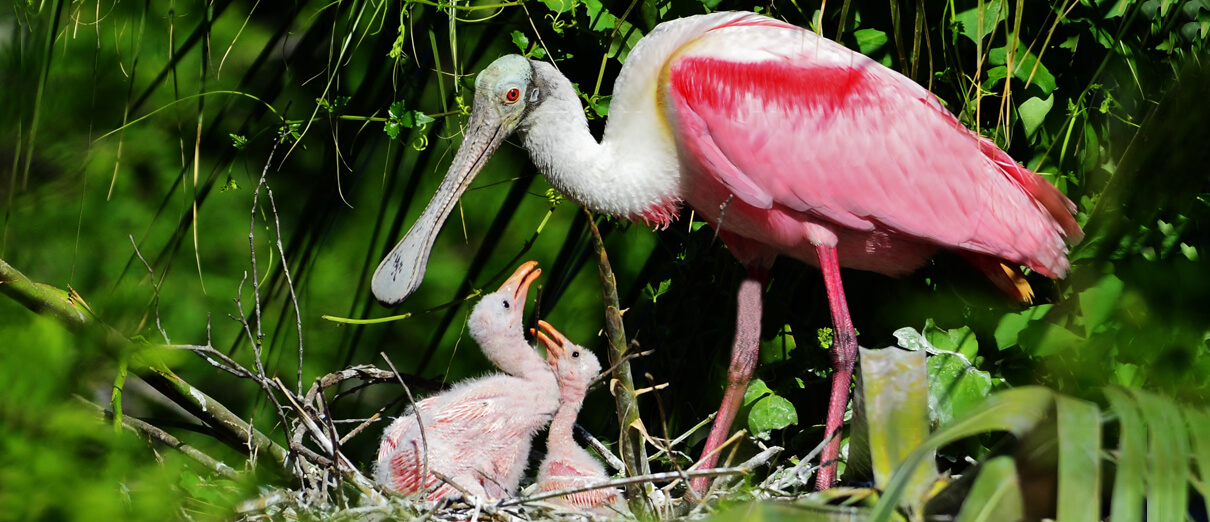
Roseate Spoonbill adult and nestlings. Photo by Gareth Rasberry.
The nest is usually built from five to 15 feet up in a tree or shrub, including in mangroves. The female, mainly, fashions sticks into a crude platform, with a shallow depression lined with finer plant materials including twigs and leaves. Then she usually lays two or three brown-spotted eggs. Both parents take turns incubating the eggs for three weeks or a few days longer. Once hatched, nestlings stay in and around the nest for up to six weeks. By two months of age, they are strong fliers.
Wading Back from the Brink
By the time the plume trade peaked in the late 1800s, the large, pink, colonially nesting Roseate Spoonbill had become rare in North America. An easy target, its feathers were prized for use in fans, hats, and decorative screens. In addition, its habit of nesting with other wading birds meant that when hunters targeted the fine plumes of breeding egrets, the spoonbills' nest sites were also ravaged.
In his 1895 field guide entitled Birds of Eastern North America, Frank M. Chapman wrote of the Roseate Spoonbill's status: “This was formerly a common species in Florida, but continued persecution has so reduced its numbers that during four winters passed in different parts of the State I did not observe it.” By the 1940s, even after decades of protecting these birds, the spoonbill only nested at one site in South Florida, in a bit of southwestern Louisiana, and a number of spots along the Texas Gulf Coast.
Today, the Roseate Spoonbill is doing better, although it remains uncommon in its U.S. range and is listed as a species of concern in Florida and Louisiana.
Over the decades, habitat loss has also taken a toll on this species. In the U.S., Roseate Spoonbill nesting colonies fall within both public and private protected areas. Breeding wading birds are very sensitive to disturbance and pollution, so protection and restoration of these wetlands are critical for the long-term survival of this beautiful wader.
In some areas, climate change likely plays a hand in causing spoonbills to abandon traditional nesting sites, such as those in Everglades National Park. There, many believe spoonbills left nesting areas due to both coastline change and hydrology disrupted by decades of South Florida flood control. Other colonies, however, have appeared on Florida's mainland and southwestern coast.
Some climate models show that in coming decades, this species might be able to move with coastal change and extend its range northward with rising temperatures. These volatile conditions will challenge conservationists striving to provide long-term protection for wading bird colonies, especially in areas where little wetland habitat remains.
Donate to support ABC's conservation mission!





































